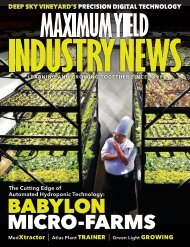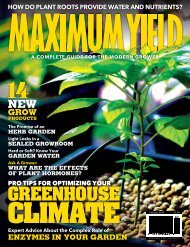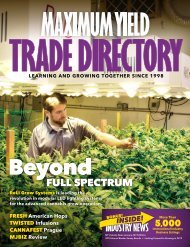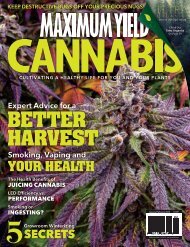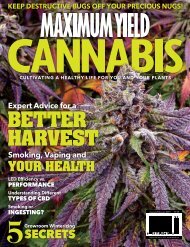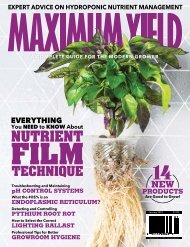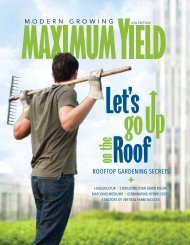Maximum Yield Canada July/August 2017
While hydroponics is unlikely to overtake traditional agriculture economically anytime soon—current US annual crop production is estimated at $143 billion while hydroponics is valued at a mere $600 million—it’s not so much as how much is being grown but where. Today, nobody knows what society will be like in 2100. We hope it will be a peaceful, healthy, and happy place.
While hydroponics is unlikely to overtake traditional agriculture economically anytime soon—current US annual crop production is estimated at $143 billion while hydroponics is valued at a mere $600 million—it’s not so much as how much is being grown but where. Today, nobody knows what society will be like in 2100. We hope it will be a peaceful, healthy, and happy place.
You also want an ePaper? Increase the reach of your titles
YUMPU automatically turns print PDFs into web optimized ePapers that Google loves.
leaf surface temperature<br />
Yellow Mangosteen (Garcinia xanthochymus)<br />
Yellow Mangosteen (Garcinia xanthochymus)<br />
240W all-white LED 240W plant-optimized LED<br />
75°F ambient air temperature 84°F ambient air temperature<br />
75°F ambient air temperature 84°F ambient air temperature<br />
1,000W High Pressure Sodium 750W Plant-optimized LED<br />
75°F ambient air temperature 84°F ambient air temperature<br />
75°F ambient air temperature 84°F ambient air temperature<br />
Purple: plant-optimized LED spectrum<br />
Orange: all-white LED spectrum<br />
Green: relative photosynthetic efficiency by wavelength<br />
Fig. 1<br />
Purple: plant-optimized LED spectrum<br />
Orange: HPS spectrum<br />
Green: relative photosynthetic efficiency by wavelength<br />
Fig. 2<br />
The FLIR images in Fig. 1 were taken with the same plants on<br />
the same day under otherwise identical conditions, with only<br />
the ambient air temperature and light spectrum changed.<br />
This shows the same leaf under two different light<br />
spectrums (both provided by 240W LED lights), under two<br />
different ambient air temperatures. In the warmer ambient<br />
environment of 84°F, the LST difference between the 89.2°F<br />
and 92.3°F shown in the image is over 3°F. Note the leaf<br />
is cooler with the plant-optimized spectrum at both<br />
ambient air temperatures. This shows that it<br />
isn’t LED technology but purely spectrum<br />
that is responsible for the different<br />
leaf temperatures. LST still increases<br />
with a less-efficient spectrum, even<br />
when the light is from LEDs.<br />
Fig. 2 shows the same plant under<br />
two different light spectrums<br />
and two different ambient<br />
air temperatures. In the 75°F<br />
ambient garden, the hottest part<br />
of the leaf is 86.5°F, but in the<br />
same environment under the<br />
1,000W HPS, the leaf hits 102°F.<br />
Note the leaf is again cooler with<br />
the plant-optimized spectrum at<br />
both ambient air temperatures.<br />
“IN SOME CASES, a plant-optimized<br />
spectrum can require air temperatures 10°F<br />
warmer to keep the plants’ leaves in the ideal<br />
temperature range to maximize yield.”<br />
52 grow cycle




